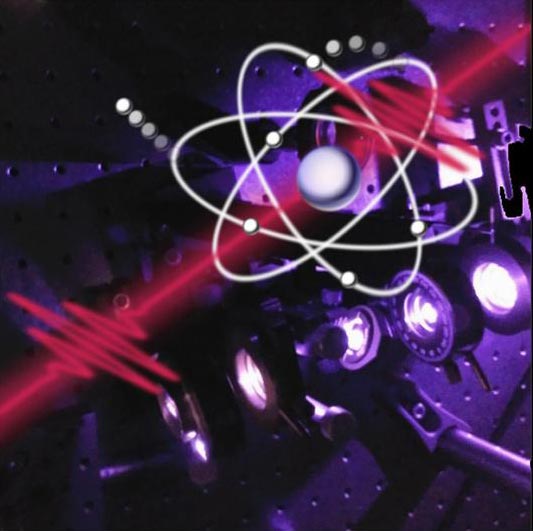Researchers observe quantum interferences in real-time using a new extreme ultra-violet light spectroscopy technique

Laser pulses generate and track electronic quantum interference in an atom. Graphic: AG Stienkemeier
To this end, the scientists excited rare gas atoms with specially prepared laser pulses. Then they tracked the response of the atoms with a new measurement technique that enabled them to study quantum mechanical effects in atoms and molecules at extremely high time resolution. The researchers present their results in the latest edition of Nature Communications.
Numerous chemical reactions, such as the breaking of bonds in molecules, are triggered by the absorption of light. In the first instant after the absorption, the distribution of the electrons in the atomic shell changes, significantly influencing the subsequent course of the reaction.
This alteration happens extremely quickly; the timescales reach into the attosecond range. Previously-used spectroscopic technologies, which use visible laser pulses, are not fast enough to track such processes.
So researchers around the world are currently developing innovative laser sources and adequate spectroscopic technologies in the ultra-violet and X-ray ranges.
Stienkemeier’s team has extended a technology known from the visible spectrum range, coherent pump-probe spectroscopy, into the ultra-violet range. This is the spectral range between X-ray radiation and ultra-violet light.
To do this, the scientists prepared a sequence of two ultra-short laser pulses in the extreme ultra-violet range at the FERMI free electron laser in Trieste, Italy. The pulses were separated by a precisely-defined time interval and had a precisely-defined phase relationship to one another.
The first pulse starts the process in the electron shell (pump-process). The second pulse probes the status of the electron shell at a later point (probe-process). By altering the time interval and the phase relationship, the researchers could reach conclusions on the temporal development in the electron shell.
“The greatest challenge was to achieve precise control over the pulse properties and to isolate the weak signals,” explains Andreas Wituschek, who was in charge of the experimental procedure.
The Freiburg physicists studied the rare gas argon, amongst others. In argon the pump-pulse causes a special configuration of two electrons within the atomic shell: this configuration disintegrates, with one electron leaving the atom in a very short time and the atom finally remaining behind as an ion.
The researchers succeeded for the first time in observing the immediate temporal decay of the quantum interference, as one electron left the atom.
“This experiment paves the way for many new applications in the study of atomic and molecular processes after selective stimulation with high-energy radiation in the extreme ultra-violet range,” says Bruder.
The research project was funded within the framework of the International Graduate School CoCo, which was established by the German Research Foundation (DFG), as well as by the COCONIS project of the European Research Council (ERC) and LoKoFEL project of the Federal Ministry of Education and Research (BMBF).
Original publication:
Wituschek A., Bruder L., Allaria E., Bangert U., Binz M., Borghes R., Callegari C., Cerullo G., Cinquegrana P., Giannessi L., Danailov M., Demidovich A., Di Fraia M., Drabbels M., Feifel R., Laarmann T., Michiels R., Mirian N.S., Mudrich M., Nikolov I., O’Shea FH., Penco G., Piseri P., Plekan O., Prince K.C., Przystawik A., Ribič P.R., Sansone G., Sigalotti P., Spampinati S., Spezzani C., Squibb R.J., Stranges S., Uhl D. & Stienkemeier F. (2020):Tracking attosecond electronic coherences using phase-manipulated extreme ultraviolet pulses. In: Nature Communications 11, 883 (2020). DOI: 10.1038/s41467-020-14721-2
Contact:
Prof. Dr. Frank Stienkemeier
Institute of Physics
University of Freiburg
Tel.: +49 761 203-7609
e-mail: stienkemeier@uni-freiburg.de
https://www.pr.uni-freiburg.de/pm-en/press-releases-2020/electrons-in-rapid-moti…
Media Contact
All latest news from the category: Physics and Astronomy
This area deals with the fundamental laws and building blocks of nature and how they interact, the properties and the behavior of matter, and research into space and time and their structures.
innovations-report provides in-depth reports and articles on subjects such as astrophysics, laser technologies, nuclear, quantum, particle and solid-state physics, nanotechnologies, planetary research and findings (Mars, Venus) and developments related to the Hubble Telescope.
Newest articles

Bringing bio-inspired robots to life
Nebraska researcher Eric Markvicka gets NSF CAREER Award to pursue manufacture of novel materials for soft robotics and stretchable electronics. Engineers are increasingly eager to develop robots that mimic the…

Bella moths use poison to attract mates
Scientists are closer to finding out how. Pyrrolizidine alkaloids are as bitter and toxic as they are hard to pronounce. They’re produced by several different types of plants and are…

AI tool creates ‘synthetic’ images of cells
…for enhanced microscopy analysis. Observing individual cells through microscopes can reveal a range of important cell biological phenomena that frequently play a role in human diseases, but the process of…





















